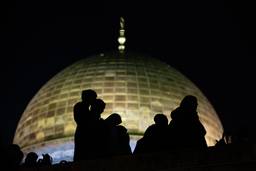In Jenin, Palestinians Resist Against Israeli Helicopters And Drones
The largest Israeli military operation in Jenin since the Second Intifada spells what Israel has in store for Palestinians.
Jehad Abusalim

In an act that can only be dubbed a theatrical display of overwhelming force, more than a thousand Israeli soldiers descended on the Palestinian town of Jenin last week and invaded the city’s refugee camp. The Israeli military flaunted a wide array of tech and weaponry as if they were going to combat against another well-equipped army: Apache helicopters, a collection of drones, D-9 bulldozers, troop carriers, and armored personnel carriers that included the Panther and Tiger models.
The incursion quickly reminded Palestinians of the deadly assault on the refugee camp during the Second Intifada in 2002.
Last week’s 48-hour operation began on July 3 and targeted the small (less than half a square kilometer in area) camp. It ended with at least a dozen dead Palestinians.
Israel, primarily driven by a desire for territorial expansion, aims to occupy as much Palestinian land as possible and drive out as many Palestinians as possible. This desire, once veiled by a facade of democracy and scientific advancement, now blatantly defines the Israeli government’s objectives. The current Israeli government is the most right-wing in its history, and it’s now common for Israeli leaders to unabashedly call for the complete annexation of the Occupied Territories and the expulsion of Palestinians.
Overall, this assault on Jenin, coupled with other unfolding events in the West Bank like recent settler attacks, signifies the complete disintegration of the post-Second Intifada status quo. The international community’s imposed pacification of Palestinians, juxtaposed with their tacit approval of Israel’s expanding settlements — and settler violence — underscores the bleak scenario.
It suggests a grim future strategy: the direct and violent expulsion of Palestinians.
This has historically meant the inevitability of resistance. Palestinians, faced with aggression, encroachment and expulsion from their land are left with no choice but to resist against Israel. After years of failed promises, they are compelled to safeguard their homes, their heritage and their future.
But what this will result in is a fight between the relentless encroachment of the settler-colonial state, its settlers and the defensive resistance of the indigenous population. The scale and intensity of this fight may soon reach an unprecedented point, leading to severe consequences.
This most recent assault in the West Bank provides a crucial insight into Israel’s intentions. The area witnessed relative calm after the Palestinian legislative elections in 2006, and the subsequent political schism in 2007. However, the calm came at a steep price.
The Palestinian Authority’s (PA) security forces, in coordination with Israel, have ensured a modicum of stability in the region. But that stability has come at the cost of political suppression and the stifling of Palestinian resistance against Israel. The PA champions policies of security coordination with Israel that they claim will pave the path to Palestinian statehood and independence, while aligning with the expectations of the international community.

In the undercurrent of the PA’s policies of collaboration, Israel has continued its oppressive operations — expanding settlements, imposing a harsh blockade on Gaza, and persistently undermining the possibility of peaceful resolution. At the same time, Israeli settlers have grown more aggressive, and the Israeli government, under Prime Minister Benjamin Netanyahu’s leadership, have encouraged them, further blurring the line between the state and the settler movement.
Amidst all this, the PA — and many hopeful international observers — have clung to their dwindling hope of a two-state solution, which is now more unrealistic than ever. Meanwhile, the rest of the Palestinian people have moved forward without them, taking action to resist their oppression.
Palestinians frequently rise in protest — in response to assaults like the one we saw last week, to settler violence, and to persistent state violence — demonstrating their determination to challenge the Israeli state.
The PA, perceived as weak and fragmented, has not been able to convince its people that diplomacy can yield statehood. And now, PA President Mahmoud Abbas’ health is in decline and there’s a looming leadership vacuum that raises concerns. Potential successors lack both experience and popular support.
While the fate of the PA remains uncertain, the rising defiance on Palestinian streets paints a clearer picture of the future, as exemplified by recent events in Jenin: a new generation of Palestinians, disillusioned by the PA and witnessing the growing Israeli presence, are rising in anger and frustration against the bleak future that awaits them. This generation’s determination to fight back signals a shifting dynamic in this inevitable clash between natives and settlers.
Despite Israel suggesting the grim future strategy of more expulsion, Palestinians are still rising up against all odds, uniting across physical and political boundaries, cognizant that their survival hangs in the balance. This fight for their existence in the face of looming displacement is a reality they are confronting with resolute determination. Predicting the outcome of this struggle is challenging, but their readiness to defend themselves is unflinching.
This raises a critical question for the international community: how much longer will it remain a passive spectator to the plight of the Palestinians? The world must answer this question urgently, as the stakes continue to escalate in alarming ways.
Jehad Abusalim is Executive Director of the Institute for Palestine Studies — USA and coeditor of Light in Gaza: Writings Born of Fire.








